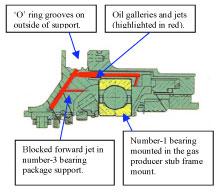On 28 July 2004, a British Aerospace PLC, BAe 146 aircraft, registered VH-NJA, was in cruise flight at flight level (FL) 280, on a scheduled passenger service from Brisbane to Adelaide. At 1245 EST, the flight crew (crew) felt and heard a light to moderate rumbling and grinding noise.
A check of the aircraft and engine instruments indicated that the number 4 engine had a rapidly decreasing N11 RPM and an N22 RPM of less than 10%. The turbine gas temperature (TGT) for that engine appeared to indicate zero and the thrust management system (TMS) showed an error message and a 'Test Fail' indication.
The crew shut the engine down in accordance with the operator's abnormal checklist procedures and turned off the TMS. A fire bottle was discharged into the number 4 engine cowling area as a precaution.
The crew informed the cabin crew of the engine failure, with one of the flight attendants reporting having seen sparks coming from the engine.
The crew contacted air traffic control (ATC) requesting a descent to FL150 to start the auxiliary power unit (APU). The passengers were also advised that a generator failure had occurred. The air traffic controller later contacted the crew asking if operations were normal. At that time, they informed ATC that the engine had failed and that they were continuing to Adelaide. The crew advised that they would not be declaring an emergency.
After starting the APU, the crew climbed the aircraft to FL240 and continued to Adelaide.
The failed ALF502R-5(-103A) engine, serial number LF05932, was removed from the aircraft and forwarded by the Australian Transport Safety Bureau (ATSB) to the engine manufacturer in the US. An investigation of the failed engine was carried out by the engine's manufacturer in August 2004, with a representative of the US National Transportation Safety Board present on behalf of the ATSB.
The investigation found that the engine failure resulted from the failure of the high-pressure compressor rotor, number 1 bearing, due to high temperature damage resulting from insufficient lubrication. The number 1 bearing was located in the stub frame mount in the engine's gas producer module (see diagram).
Lubricating and cooling oil was supplied to the bearing via two jets: one each for the front and rear of the bearing.
Oil was ported to the two oil jets through galleries located in the number 3 bearing support assembly. The oil supply galleries and jets were sealed by two 'O' ring packings that were positioned on the outside diameter of the number 3 bearing support assembly.
Examination of the number 3 bearing package support assembly found that both 'O' rings on the outside diameter of the support had multiple 'nibbles' (small missing pieces) around their circumference. The forward 'O' ring had also been cut completely through. Sectioning of the number 3 bearing support found that the oil jet that supplied lubrication to the front of the number 1 bearing was also blocked with 'O' ring material. Analysis of that material found it was consistent with the missing pieces of 'O' ring from the outside of the number 3 bearing package support.
The engine manufacturer estimated that leakage past the damaged 'O' ring and the blocked oil jet had reduced the lubricating and cooling oil supply to the number 1 bearing by approximately 50 to 60 percent. The report further indicated that all other engine damage noted had resulted from the failure of the number 1 bearing.
The ATSB determined that the number 3 bearing package support was last removed from the engine by the aircraft operator during maintenance on 24 December 2003. The bearing package support had been removed to facilitate the fitment of new carbon seals to the number 1 and number 3 bearings. During that maintenance, both 'O' rings on the support were replaced. At the time of the engine failure, the engine had completed 975 hours and 706 cycles since that maintenance. Information from the operator indicated that there had been no history of excessive oil usage or excessive vibration on the trend graphs for the engine.
- N1 (NL) engine low pressure turbine and fan RPM.
- N2 (NH) engine high pressure compressor and turbine RPM



